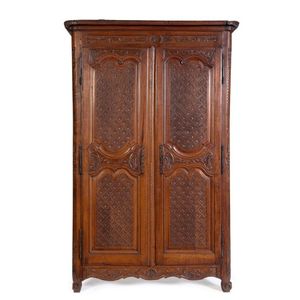Serpentine Walnut Credenza with Marquetry and Ormolu Accents
You must be a subscriber, and be logged in to view price and dealer details.
Subscribe Now to view actual auction price for this item
When you subscribe, you have the option of setting the currency in which to display prices to $Au, $US, $NZ or Stg.
- Inlay - Decorative patterns inserted into the main body of a piece of furniture, generally in wood of contrasting colour and grain, though brass, ivory, ebony, shell and sometimes horn have been used. Inlay may consist of a panel of well figured timber inset into a cabinet door front, geometric patterns, or complex and stylized designs of flowers, swags of foliage, fruits and other motifs. As a general rule, in pieces where the carcase is constructed in the solid, the inlay is relatively simple such as stringing, cross banding and herringbone banding. Where more elaborate and decorative work was required veneer was used. Inlay has been fashionable from at least the latter half of the 17th century, when a variety of elaborate forms were developed
- Serpentine - Resembling a serpent, in the form of an elongated 'S'. A serpentine front is similar to a bow front, except that the curve is shallow at each end, swelling towards the middle. The term presumably derives from its similarity to a moving snake or serpent. Serpentine fronts are usually veneered, with the carcase either being cut and shaped from a solid piece of timber, or built in the 'brick' method.
- Marquetry - In marquetry inlay, contrasting woods, and other materials such as ivory, shell and metal are inlaid either as panels or in a single continuous sheet over the surface of the piece. The design may be straightforward, such as a shell pattern or a basket of flowers, or it may be infinitely complex, with swirling tendrils of leaves, flowers and foliage, such as one finds, for example, in the "seaweed" patterns on longcase clocks of the William and Mary and Queen Anne periods.
- Ormolu - Ormolu was popular with French craftsmen in the 18th and 19th century for ornamental fittings for furniture, clocks and other decorative items. True ormolu is gilt bronze, that is bronze that has been coated with gold using a mercury amalgam. Due to the health risks associated with using mercury, this method of creating ormolu was discontinued in France in the 1830s. A substitute was developed consisting of about 75% copper and 25% zinc, however it was inferior to the bronze version. It was often lacquered to prevent it tarnishing.
- Figured - A descriptive term to describe the patterns in the grain of timber. An object may be described as "well figured" or "highly figured" if the grain on a section of the object is highly patterned, as with flame mahogany or burr walnut.
This item has been included into following indexes:
-
cabinets, material
- ormolu and bronze mounted 224
- walnut 665
- credenza - without mirror back 118
- side cabinets 226
Visually similar items

Antique French Henri II bookcase buffet, 240 cm high, 140 cm wide

An antique Flemish heavily carved walnut bookcase, circa 1860. Featuring mythological caryatids, 240 cm high, 164 cm wide, 59.5 cm deep. Provenance: Purchased from a chateau in Lille

Antique French Henri II carved oak two height hunting buffet, approx 250 cm high, 141 cm wide

A large French walnut armoire, 17th century, finely carved throughout, 250 cm high, 130 cm wide, 60 cm deep
